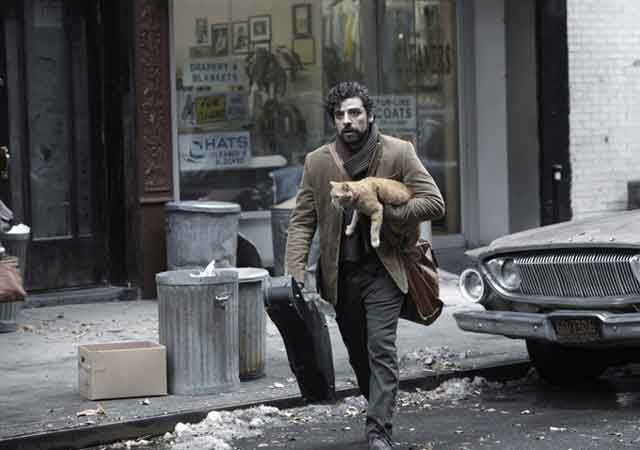
Joel and Ethan Coen make films that should be too odd and oblique for the mainstream, reaping piles of awards, rave reviews and a measure of commercial success in return. The brothers’ latest film — the circuitous, downbeat Inside Llewyn Davis — spares a thought for an artist whose work isn’t as well received. There they go, but for the grace of God.
Set during a bitter New York winter, Inside Llewyn Davis plays out over a week in the life of a struggling folk singer trying to make a career in the Greenwich Village folk scene of the early 1960s. Inside Llewyn Davis uses as its point of departure for the film a book by Dave Van Ronk, one of the leading lights of the 1960s Village folk scene.
A typically luckless Coen protagonist, Llewyn Davis (Oscar Isaac) couldn’t differ more from the mellow and popular Van Ronk in appearance, temperament or performing style. From an alleyway beating in the opening minutes — one of many surreally funny episodes in the film — the Coens put him through the wringer for nearly two hours.
Llewyn’s musical partner has committed suicide, his solo album isn’t selling, he is homeless and he is so poor that he huddles against New York’s chill with no coat to protect him. What’s more, he has possibly impregnated fellow folkie Jean (Carey Mulligan), who happens to be the singing partner and lover of his friend Jim (Justin Timberlake).
And it’s not as if all of Llewyn’s misfortune is completely undeserved. He’s unsparingly portrayed as an egotist nourished by self-pity and starved of self-awareness, one with thoughtless contempt for those that don’t meet his merciless standards of purity and commitment. He’s a sort of anti-Bob Dylan, a man unable to reinvent himself or hide from his audience behind a mask.
The Coens were insistent on casting an actor who was also a musician and singer in the role — the relatively unknown Oscar Isaac was the only one they found that fitted the bill. Isaac’s performance turns a potentially unlikable man into a sympathetic character. The more he writhes on the hooks that snare him, the deeper they dig into his flesh.
There’s something comical and delusional about Llewyn’s perseverance in the face of the adversities he faces — Isaac describes him a Buster Keaton-like figure — but the actor finds nobility in it, too. And when he sings, he shows the genuineness that keeps Llewyn going through slammed doors, face slaps and other indignities.

Supporting performances are also strong, especially Carey Mulligan as Jean, who sings in the soothing tones of an angel and spits acid when she speaks. John Goodman makes a memorable appearance as an embittered, heroin-addicted jazzman who joins Llewyn, a beat poet and a ginger cat for a bizarre cross-country odyssey.
Inside Llewyn Davis is another minor classic for the Coens, who are surely the most consistent filmmaking team of the past 30 years. Its subject matter might not appeal to some fans of Coen breakthroughs like No Country for Old Men and True Grit, but few could argue against the artistry and craftsmanship that went into the production.
Director of photography Bruno Delbonnel (Roger Deakins, the Coens’ favoured collaborator in recent films, was working on Skyfall when the film was shot) shoots the film in desaturated browns and grays that make it feel like the album cover of The Freewheelin’ Bob Dylan come to life. T-Bone Burnett — who also collaborated with the Coens on O Brother Where Art Thou and The Big Lebowski — oversees the music with a perfectionist’s eye. Songs from the era are performed by the cast in front of the cameras and in their entirety, giving Inside Llewyn Davis an air of musical authenticity.
This sense of place and time is carried through to the perfect closing moments of the film — the Coens are among the few filmmakers today who know how to end a film just right — where we see music history in the making. The road splits as one man becomes a legend and another an obscurity. There is perhaps little more than dumb luck that separates them. — (c) 2014 NewsCentral Media
- Watch: The Making of Inside Llewyn Davis
- Read more: Why Inside Llewyn Davis Doesn’t Get Inside the Village and Meet the Folk Singer Who Inspired Inside Llewyn Davis




